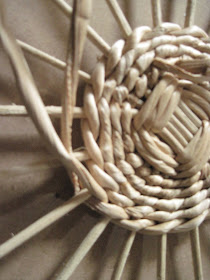The manner in which groups of warp yarns are raised to permit the insertion of the filling yarn determines the pattern of the weave. Weave patterns can create varying degrees of durability, adding to their usefulness and also to their appearance.
Plain weaveThe plain weave is sometimes referred to as the tabby, homespun or taffeta weave. It is the simplest type of construction and is consequently inexpensive to produce. Each filling yarn goes alternately under and over the warp yarns across the width. On its return, the yarn alternates the pattern of interlacing.
 Basket weave
Basket weaveThe variation of the plain weave known as the basket weave uses double yarns to produce the design that resembles the familiar patterns of a basket. Two or more filling yarns are interlaced with a corresponding number of warp yarns. They are woven in a pattern of 2X2, 3X3, 4X4, instead of 1X1, which is plain weave. Many variation of the yarn construction of the basket weave are possible. For example, there may be a 3X2 or a 5X3 and so on. The size or thickness of the combined warp yarns will, however, always equal the size or thickness of the corresponding filling yarns. This provides certain degree of balance and pattern.
 Ribbed effects
Ribbed effectsRibbed, or corded, effects are further variations of the plain weave. The rips may be produced in the warp by alternating single yarns with double yarns. Warp-ribbed surface is usually referred to as waled or corded.
 Twill weave
Twill weaveA distinct design in the form of diagonals is characteristic of the second basic weave, called twill. Changes in the direction of the diagonal lines produce variations, such as the herringbone, corkscrew, entwining, and fancy twill. Increased ornamentation may be obtained by varying the slant of the diagonal and yarn colors. The values of the twill weave include its strength and durability. Also, twill is frequently more tightly woven and will not get dirty as quickly as the plain weave.
In the twill weave, the filling yarn interlaces more than one wrap yarn but never more than four, as strength would be sacrificed by doing so. On each successive line, or pick, the filling yarn moves the design one step to the right or to the left, thus forming the diagonal. Whichever the direction of the diagonal on the face of the surface, the design runs in the opposite direction on the reverse side.
When the direction of the diagonal starts from the upper left-hand side of the fabric and moves down toward the lower right, it is called a left-hand twill. When the direction of the diagonal starts from the upper right-hand side of the fabric and moves down toward the lower left. It is called a right-hand twill.
The steepness of the diagonal can indicate strength and durability, the steeper the twill the stronger the surface is likely to be. Twill weaves are also classified as even or uneven according to the number of faces of the fabric. The even twill, for example, shows an equal number of warp and filling yarns in the recurring design, such as two over and two under.
Most twill weaves are uneven. An uneven twill may show more warp than filling yarn in the recurring design, this is called a warp-face twill.

Satin weaveIn basic construction satin weave is similar to twill weave. It differs in appearance from the twill weave because of the diagonal of the satin weave is not visible. It is purposely interrupted in order to contribute to the flat, smooth surface. There is no visible design on the face of the fabric because yarn that are to be thrown to the surface are greater in number.
























